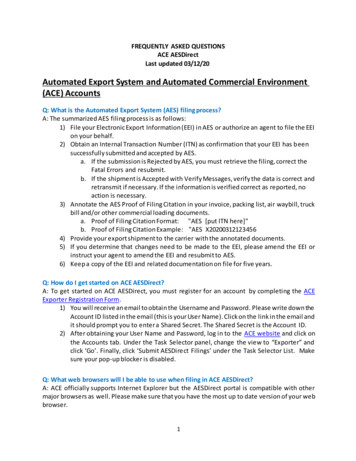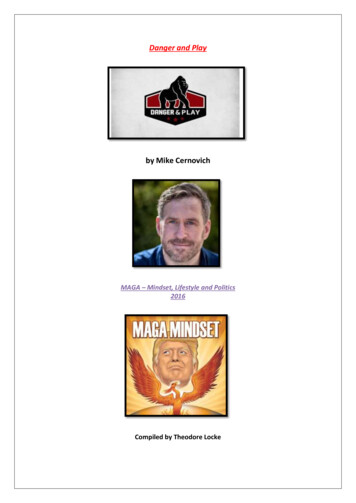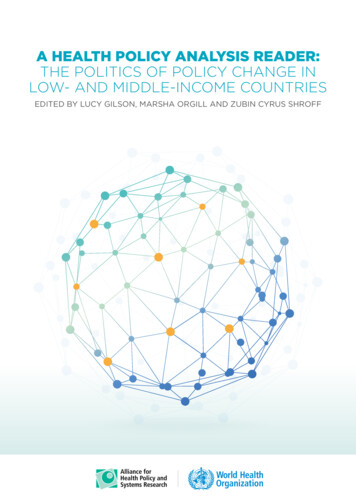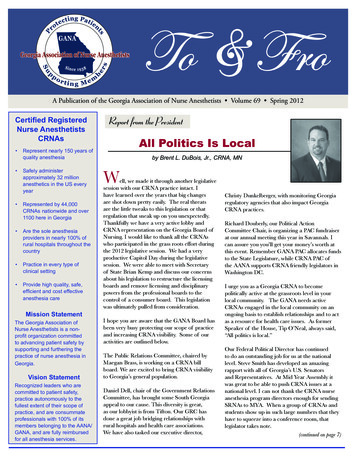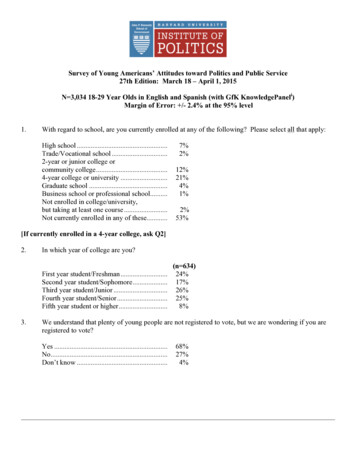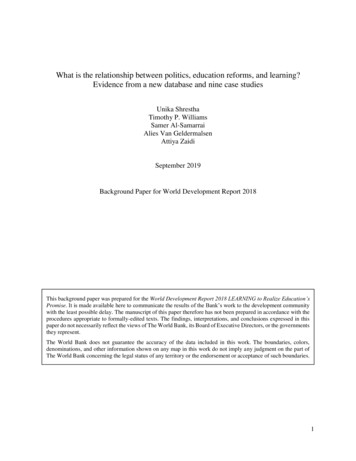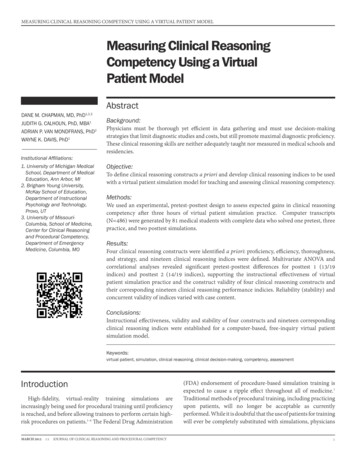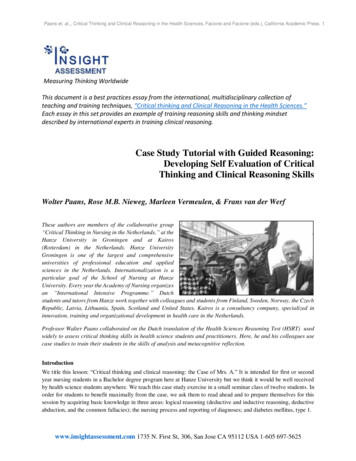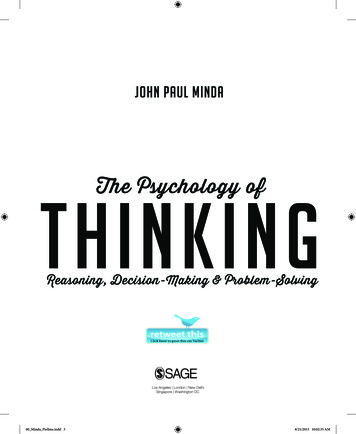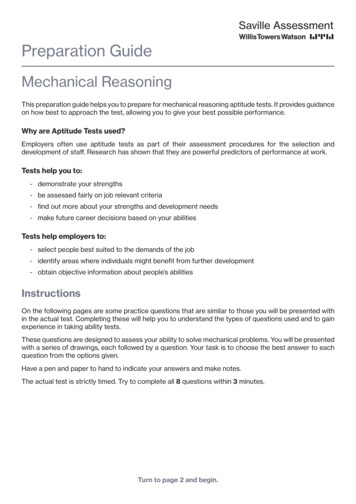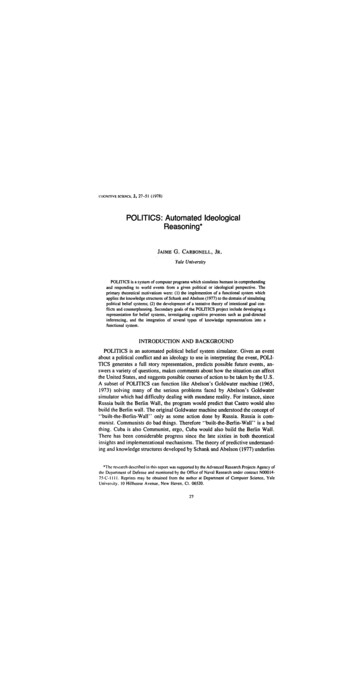
Transcription
Downloaded By: [Carnegie Mellon University] At: 21:22 3 July 2008C.OCNITIVE SCIENCE.2 927-51 (1978)POLITICS: Automated IdeologicalReasoning*Yale UniversityPOLITICS is a system of computer programs which simulates humans in comprehendingand responding to world events from a given political or ideological perspective. Theprimary theoretical motivations were: (1) the implemention of a functional system whichapplies the knowledge structures of Schank and Abelson (1977) to the domain of simulatingpolitical belief systems; (2) the development of a tentative theory of intentional goal conflicts and counterplanning. Secondary goals of the POLITICS project include developing arepresentation for belief systems, investigating cognitive prncesses such as goal-directedinferencing, and the integration of several types of knowledge representations into afunctional system.INTRODUCTION AND BACKGROUNDPOLITICS is an automated political belief system simulator. Given an eventabout a political conflict and an ideology to use in interpreting the event, POLITICS generates a full story representation, predicts possible future events, answers a variety of questions, makes comments about how the situation can affectthe United States, and suggests possible courses of action to be taken by the U.S.A subset of POLITICS can function like Abelson's Goldwater machine (1965,1973) solving many of the serious problems faced by Abelson's Goldwatersimulator which had difficulty dealing with mundane reality. For instance, sinceRussia built the Berlin Wall, the program would predict that Castro would alsobuild the Berlin wall. The original Goldwater machine understood the concept of"built-the-Berlin-Wall" only as some action done by Russia. Russia is communist. Communists do bad things. Therefore "built-the-Berlin-Wall" is a badthing. Cuba is also Communist, ergo, Cuba would also build the Berlin Wall.There has been considerable progress since the late sixties in both theoreticalinsights and implementational mechanisms. The theory of predictive understanding and knowledge structures developed by Schank and Abelson (1977) underlies*The reaei rchdescribed in this report was supported by the Advanced Research Projects Agency ofthe Department of Defense and monitored by the Office of Naval Research under contract N0001475-C-II I I. Reprints may be obtained from the author at Department of Computer Science, YaleUniveraity. 10 Hillhouse Avenue, New Haven. Ct. 06520.
Downloaded By: [Carnegie Mellon University] At: 21:22 3 July 200828CARBONELL, JR.much of the implementation of POLITICS, distinguishing it from Abelson'searlier effort. Many of the problems of dealing with mundane reality have beensolved by the use of scripts (dicussed below) and by infemng the intention of theactors in the events being interpreted.Several theoretical issues were encountered in the process of creating a working system. These issues led to some new ideas and representations such as thefollowing: A functional representation for an ideology was developed which theprograms can take easily as input data. This enables POLITICS to model anyreasonable political ideology. Goal-directed inferencing processes were developed to interact with scripts, thereby making scripts more strongly predictivethan in other implementations (e.g., Cullingford, 1977). Counterplanningstrategies were investigated to a limited degree in order to model and understandthe ways in which political entities often scheme to thwart each other's goals.Some new question-answering strategies were developed to interrogate hypothetical and predictive information. When POLITICS encountered previously unknown facts necessary to interpret an event, a limited form of learning aboutobjects and ploitical entities in the world model was developed to increase itseffectiveness.This paper focuses on three of the more significant aspects of the POLITICSproject. The representation and function of political ideologies in understandingevents is analyzed and proposed as a theory to account for differing ideologicalinterpretations of the same event. Counterplanning strategies and rules are developed to model the process whereby countries or people scheme to preventeach other from achieving their respective goals. The encoding of mundaneworld knowledge as scripts and context-dependent inference rules is discussed insome detail where it applies to the processing of the sample political events.There are some notational conventions which help us to read a POLITICSprotocol: A "#" preceding a word means that the word represents a conceptualclass of objects in POLITICS memory; for instance, #PERSON, #ORG (fororganization), #COUNTRY, and #WEAPON are four of the fifteen classes ofreal world objects that POLITICS knows about. A word preceded and followedby asterisks is a pointer to a specific memory token. A " " preceding a worddesignates the name of a script.POLITICS: THE INTERPRETATION OF A POLITICAL EVENTHere is the actual protocol in processing a political event. The computer outputhas been captalized to distinguish it from input typed in by a person.U.S.-Conservative Interpretation of Event ( I )*(INTERPRET USCONSERVATIVE)INPUT TEXT: The United States Congress voted to fund the Trident submarine project.PARSING .COMPLETED.INTERPRETING EVENT FROM A USCONSERVATIVE IDEOLOGY.
Downloaded By: [Carnegie Mellon University] At: 21:22 3 July 2008POLITICS: AUTOMATED IDEOLOGICAL REASONING29INSTANTIATING SCRIPT: FUNDINGINFERENCE: (#ARMEDFORCES PART (*US*) RANK (COMMAND)) TO RECEIVE('MONEY* AMOUNT (SUFF))INFERENCE: (#ARMEDFORCES PART (*US*) RANK (COMMAND)) TO BUILD(#WEAPON TYPE (*SUBMARINES*) NAME (TRIDENT))INFERENCE: *US* INCREASE 1N MILITARY POWERINFERENCE: GOAL OF *US* IS (#COUNTRY TYPE (*COMMUNIST*)) SlZE (LARGE)) TOFEAR *US*INSTANTIATING SCRIPT: CONFRONTATIONINFERENCE: (#COUNTRY TYPE (*COMMUNIST) SlZE (LARGE)) TO STOP EXPANDINGPOLITICAL-CONTROLINTERPRETATION COMPLETED, READY TO ACCEPT QUESTIONS.(1.1)Q: What did the U.S. Congress do this for?A: THE UNITED STATES CONGRESS WANTS THE UNITED STATES ARMED FORCES TOBE STRONGER.(1.2)Q: Why should the U.S. be stronger?A: THE UNITED STATES ARMED FORCES SHOULD BE STRONG TO STOP COMMUNISTEXPANSION.(1.3)Q: What should the U.S. do if Russia builds nuclear submarines?US.-Liberal Interpretation of Event ( I )'(INTERPRET US-LIBERAL)INPUT TEXT: The United States Congress voted to fund the Trident submarine project.PARSING. .COMPLETED.INTERPRETING EVENT FROM A US-LIBERAL IDEOLOGY.INSTANTIATING SCRIPT: FUNDINGINFERENCE: (#ARMEDFORCES PART (*US*) RANK (COMMAND)) TO RECEIVE(*MONEY* AMOUNT (SUFF))INFERENCE: (XARMEDFORCES PART (*USf) RANK (COMMAND)) TO BUILD(#WEAPON TYPE ('SUBMARINES*) NAME (TRIDENT))INFERENCE: *US* INCREASE IN MILITARY POWERINFERENCE: (#COUNTRY TYPE (*COMMUNIST*)) SlZE (LARGE)) TO BUILD(#WEAPON TYPE (*UNSPECe))INSTANTIATING SCRIPT: ARMSRACEINFERENCE: GOAL CONFLICT UNRESOLVED *US* AND (#COUNTRY TYPE (*COMMUNIST*) SlZE (LARGE))
30CARBONELL. JR.Downloaded By: [Carnegie Mellon University] At: 21:22 3 July 2008INTERPRETATION COMPLETED. READY TO ACCEPT QUESTIONS.(1)Q: What did the U.S. Congress do this for?A: THE UNITED STATES CONGRESS FEARED FALLING BEHIND IN THE ARMS RACE.(2)Q: What will Russia do next?A: RUSSIA WILL PROBABLY BUILD MORE WEAPONS.(3)Q: What should the U.S. do if Russia builds Submarines?A: THE UNITED STATES SHOULD NEGOTIATE WITH RUSSIA TO STOP THE ARMS.RACE.Question (2) is different in each Q/A dialogue because in each case it is afollow-up of the respective answer to the first question.HOW POLITICAL IDEOLOGIES ARE REPRESENTEDA political ideology is chosen before the system inputs an event to interpret.The purpose of this is to try to determine how preconcieved notions, such aspolitical ideologies, affect the understanding of events relating to potential political or military conflicts. We do not attempt to formalize exact models of anygiven ideology. Ideologies are represented as goal trees attributed to the mainactors in the political world. Goal trees determine the intentions which motivatethe actions of countries and other actors in the political world such as militaryfactions and political parties. The system uses these goal trees to predict what theactors intended to accomplish when POLITICS reads about an event describingtheir actions. Goal trees are also instrumental in predicting other goals which thepolitical actors may pursue in the immediate future.A goal tree is a set of goals for a given actor arranged in a hierarchy ofimportance and interdependence. More concretely, consider what the goal tree ofthe United States is in under a U.S.-Conservative ideology presently implemented in the POLITICS system. The primary U.S. goal is to maintain theFree World free from Communist domination. This goal has as subgoals militarycontainment of Communist aggression, preventing Communist subversion fromwithin, keeping technologically and economically ahead of the Soviet Union,and maximizing western influence in neutral nations. The first of these subgoalsalso has its own subgoals of maintaining military superiority and establishing(and maintaining) free world alliances. As the goal tree branches deeper, thegoals become more specific and instrumental to the higher level goals. Under thecurrent implementation for the Conservative ideology, the United States goal treehas 12 nodes; the Soviet goal tree has 11 nodes. The higher level goals for theSoviet Union are diagramed in Fig. 1.
Downloaded By: [Carnegie Mellon University] At: 21:22 3 July 2008POLITICS: AUTOMATED IDEOLOGICAL REASONINGTAKE POLITICAL CONTROLOF SMALL COUNTRIES1.ATTAIN POLITICAL ANDECONOMIC INFLUENCE .DEFEAT WESTERN POWERSJ'1BUILD U; ARMED FORCES1IFIG. IIt is possible for an actor to have two or more goals which may be ranked inorder of importance, but neither need be a subgoal of the other. For instance,under the U.S.-Conservative ideology the United States may have the elimination of economic foreign aid as a low importance goal (e.g., stop wasting resources sending food to India). This goal does not fit into the subgoal hierarchymentioned above for the United States. Therefore, one actor can have more thanone goal-subgoal tree where the trees themselves can be arranged into a treehierarchy as a function of importance. In practice, however, this extramechanisim does not seem necessary for POLITICS because an actor has usuallyonly one active goal-subgoal tree. The internal representation for goal trees is adirected acyclic graph to economize on storage ahen a certain goal may be asubgoal of several higher level goals. All Third World countries are assigned thesame pair of goal trees, where the top level goals are economic development andmilitary supremacy over neighboring countries. Likewise, other western industrial countries and Communist countries are respectively assigned their owncommon goal trees. Although it is the case that each country of a given category(e.g., Third World nations) may have its own set of specific goals, we do notstrive for such precision. It is unclear whether American politicians, whom weare trying to model, act on the basis of distinctions between the goals of thegovernments of the different Third World nations.The above representation for political ideologies suggests that there may be nomore to a political ideology than the set of goals which (the person subscribing tothe ideology believes) each political entity has or should have. We implementedthis theory in POLlTlCS and were encouraged by the results. One pragmaticimplication of this theory is that the POLITICS system can handle differentideologies by simply constructing the respective goal trees and reading them intothe system as data structures. In this way we have implemented the presentConservative and Liberal US. ideologies. A theoretical implication is that thereshould be no consistent differences in thinking processes or other cognitivebehavior bctwecru people having different political ideologies if tested on cogni-
Downloaded By: [Carnegie Mellon University] At: 21:22 3 July 200832CARBONELL, JR.tive tasks irrelevant to political beliefs. Since we can only speculate on whetherthe POLITICS model really reflects the way in which people encode ideologies,we shall analyze the examples given above and let the reader consider the validityof our representation for political ideologies. There is some psychological evidence to suggest that the preconceived notions of the understander about thecharacters of a story play a crucial role in the understanding process. Owens,Dafoe, and Bower (1977) have psychological test results to this effect. Wilensky(forthcoming, 1978) has found the need to model the goals of each character inthe intentional analysis of social interaction stories.Our modular goal-oriented representation of ideologies is quite different fromthose of previous efforts: Abelson (1973) represents Senator Goldwater's political ideology as a rather simple master script. The master script is internallyencoded in a procedural manner by a set of rules of the following form: If A thenB in.which case C to prevent D, where A, B, C, and D are categories of actions.Colby's (1973) representation of his belief system for PARRY appears to bedistributed throughout his programs. His "belief system" is based largely oncanned response phrases and on a story @boutpersecution by the Mafia, whichPARRY tells whenever it gets a chance.ANALYSIS OF THE POLITICS INTERPRETATION PROCESSConsider once again the U.S.-Conservative interpretation of the Trident submarine event. The Conservative ideology has been chosen by loading all theappropriate goat trees into the system. A political event is typed in English andparsed into a conceptual dependency representation (Schank, 1972) by the POLITICS conceptual analyzer, a special purpose version of Riesbeck's (1975) conceptual analyzer. The internal mechanisms of the POLITICS parser are not ofprimary interest to th
Univeraity. 10 Hillhouse Avenue, New Haven. Ct. 06520. Downloaded By: [Carnegie Mellon University] At: 21:22 3 July 2008 28 . solved by the use of scripts (dicussed below) and by infemng the intention of the actors in the events being interpreted. Several theoretical issues were encountered in the process of creating a work- ing system. These issues led to some new ideas and representations .
